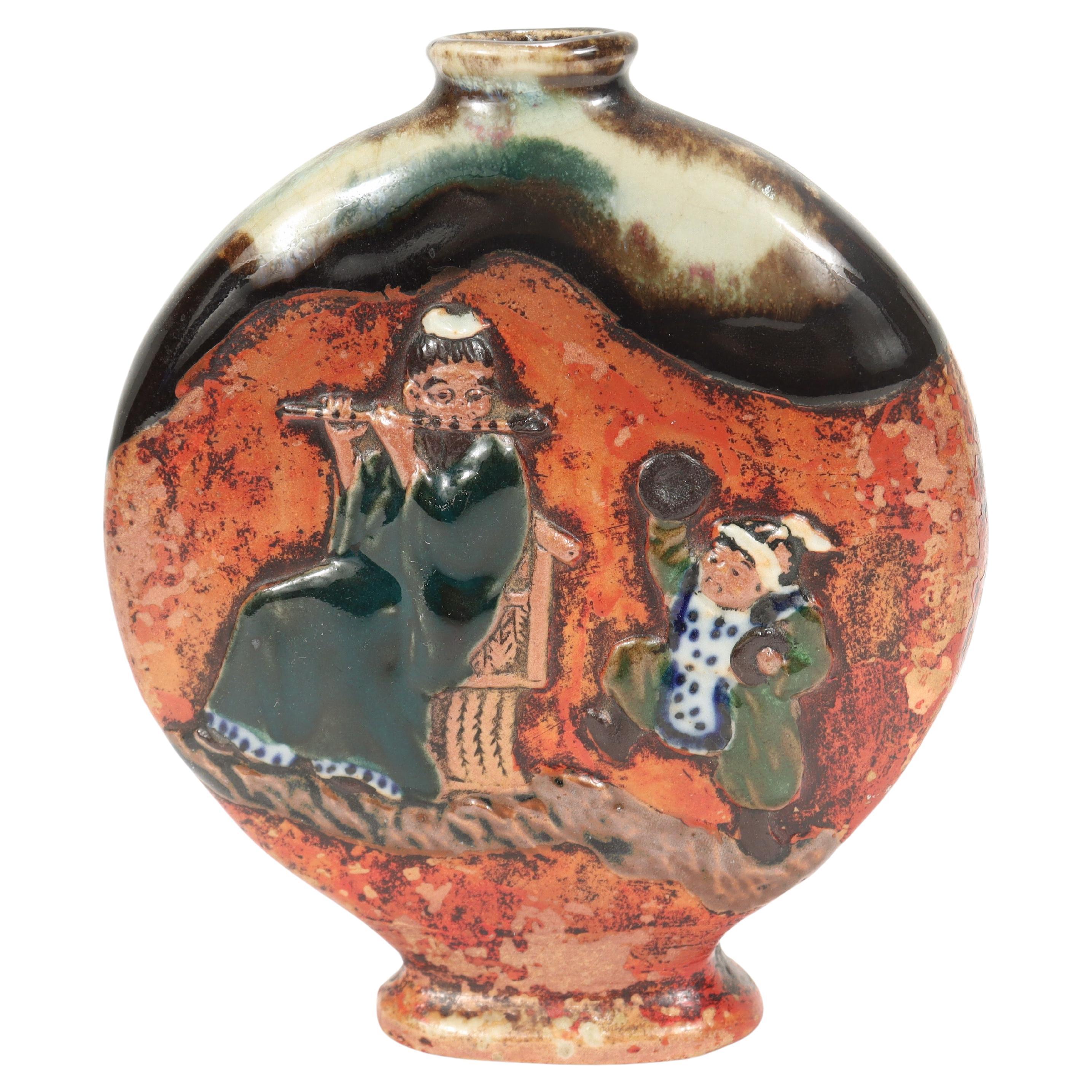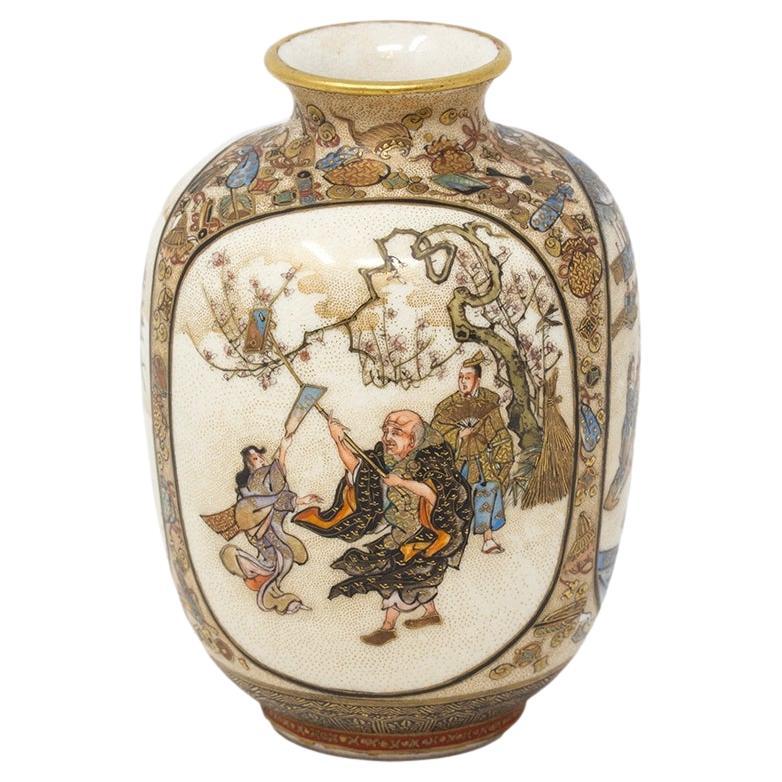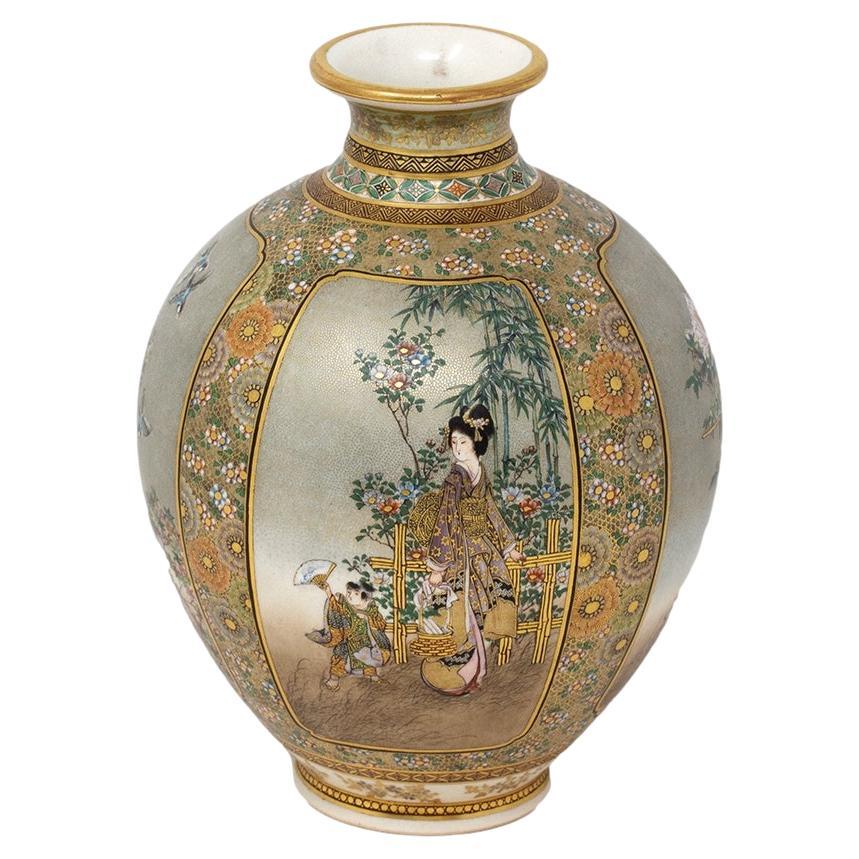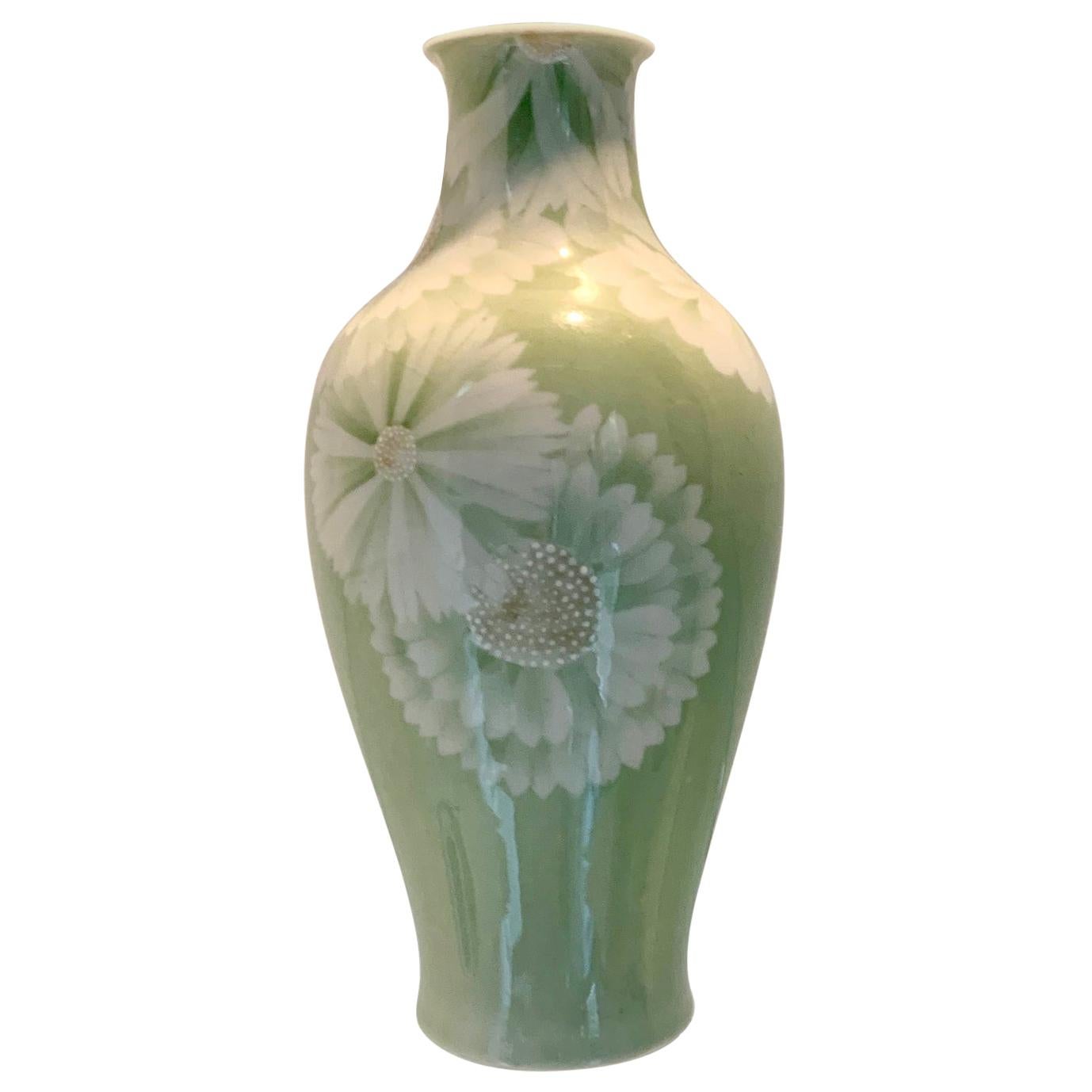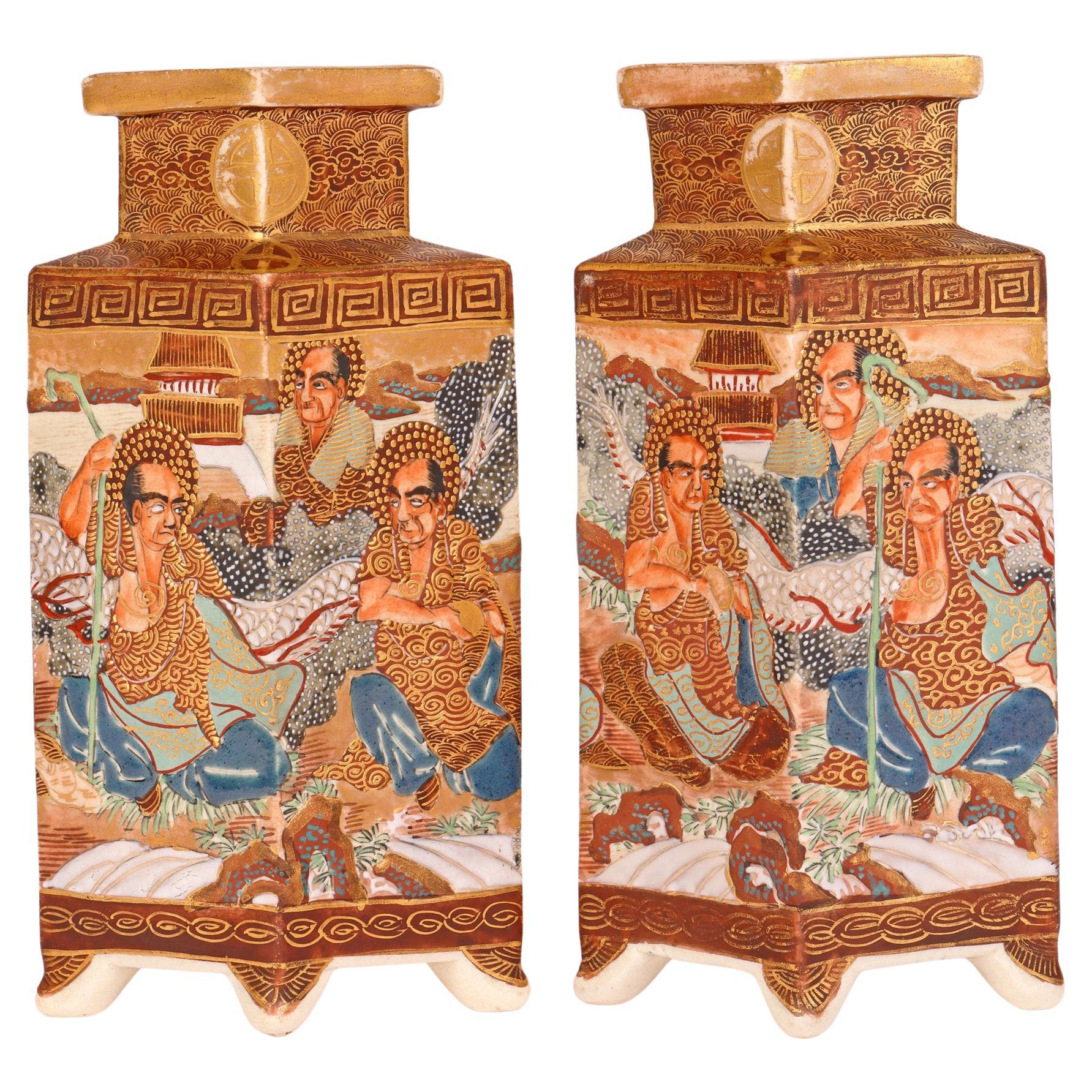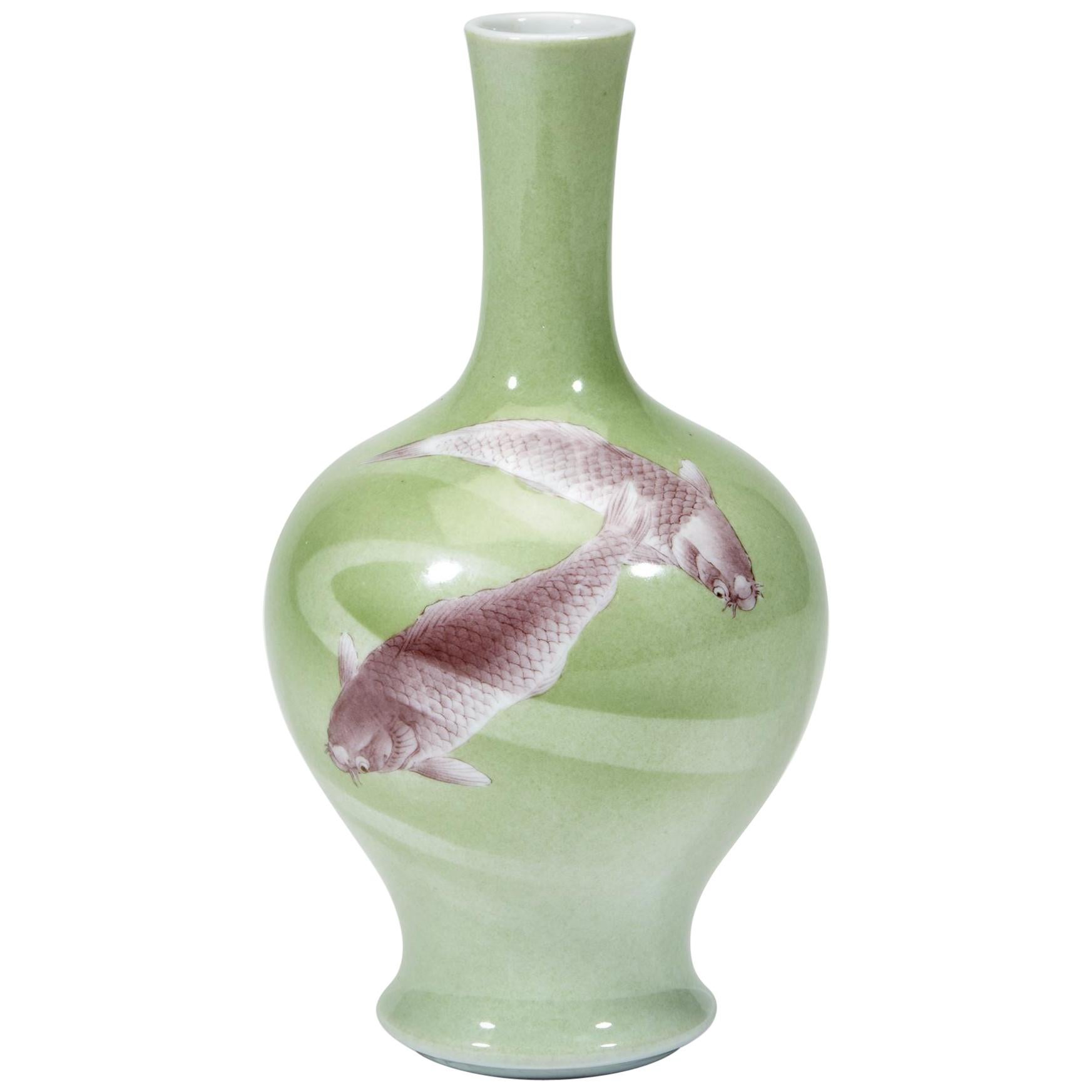Items Similar to Sumidagawa pottery Monkeys vase, Ban-Ni, Japan, Meiji Period.
Want more images or videos?
Request additional images or videos from the seller
1 of 14
Sumidagawa pottery Monkeys vase, Ban-Ni, Japan, Meiji Period.
About the Item
Sumidagawa ‘Monkeys’ vase, Ban-Ni, Japan, c. 1890, Meiji Period.
£1,350.00
Sumidagawa pottery vase, signed Ban-Ni, Japan, c. 1890, Meiji Period. The large vase, sculpted with an amusing scene of numerous monkeys clambering over rocks, some wearing short jackets, decorated in various glazes. The neck applied with a thick running high fired glaze, varying from green, through brown to blue.
All upon a red ground.
Signed Ban-Ni, in underglaze blue, to a gourd shaped tablet.
Height – 32 cm, 12 5/8”.
Diameter – 18.5 cm, 7 1/4”.
Condition – Excellent. No damage.
- Creator:Sumida Gawa (Manufacturer)
- Dimensions:Height: 12.6 in (32 cm)Diameter: 7.29 in (18.5 cm)
- Style:Meiji (Of the Period)
- Materials and Techniques:Pottery,Fired
- Place of Origin:
- Period:
- Date of Manufacture:1890
- Condition:Wear consistent with age and use.
- Seller Location:Gargrave, GB
- Reference Number:1stDibs: LU4397139089582
About the Seller
5.0
Vetted Seller
These experienced sellers undergo a comprehensive evaluation by our team of in-house experts.
Established in 1982
1stDibs seller since 2019
44 sales on 1stDibs
Typical response time: 1 hour
- ShippingRetrieving quote...Ships From: Gargrave, United Kingdom
- Return PolicyA return for this item may be initiated within 1 day of delivery.
More From This SellerView All
- Kutani porcelain cat, Japan, c. 1900, Meiji Period.By Kutani StudioLocated in Gargrave, North YorkshireKutani porcelain okimono of a cat, c. 1900. Meiji Period. £490.00 Kutani porcelain okimono, Japan, c. 1900. Meiji Period. Finely modelled as a sleeping cat, its hair delineated in g...Category
Antique 1890s Japanese Meiji Ceramics
MaterialsPorcelain
- Kutani porcelain Green Pheasant, Japan, Meiji Period.By Kutani StudioLocated in Gargrave, North YorkshireKutani porcelain okimono of a Japanese Green Pheasant, Japan, Meiji Period. The pheasant modelled, perched upon a large gnarled branch. Decorated in typically vibrant enamels, and he...Category
Antique Early 1900s Japanese Meiji Ceramics
MaterialsPorcelain
- Imari ‘Black Ship’ bowl and cover, Japan, Meiji Period.By Imari PorcelainLocated in Gargrave, North YorkshireA Japanese Imari porcelain ‘Black Ship’ bowl and cover, Meiji Period. The bowl hand painted to one side with a large sailing ship with Dutch flags, whilst t...Category
Antique 19th Century Japanese Meiji Ceramics
MaterialsPorcelain
- Imari porcelain Carp dish, Arita, Japan, c. 1890, Meiji Period.By AritaLocated in Gargrave, North YorkshireJapanese Imari porcelain Carp dish, Arita, c. 1890, Meiji Period. The canted rectangular dish, moulded to the centre with a large carp, in low relief, hand painted in typical Imari c...Category
Antique 1890s Japanese Meiji Ceramics
MaterialsPorcelain
- Japanese ormolu mounted Imari bowl & cover, c.1700. Edo Period.By AritaLocated in Gargrave, North YorkshireA large Japanese Imari bowl and cover, c. 1700, Arita, Edo Period, with 19th Century French ormolu mounts. The deep sided bowl, hand painted with alternating panels of flowering plan...Category
Antique Early 1700s Japanese Edo Ceramics
MaterialsPorcelain
- Kenjo Imari Tokuri, Arita, Japan, circa 1700, Genroku PeriodBy AritaLocated in Gargrave, North YorkshireJapanese Imari porcelain tokuri, Arita, circa 1700, Genroku Period. The squared vessel painted with shaped panels of flowering plants, upon textile design inspired grounds. Rising to...Category
Antique Early 1700s Japanese Edo Ceramics
MaterialsPorcelain
You May Also Like
- Antique Sumidagawa Signed Pottery Moon Flask VaseLocated in Philadelphia, PAA fine antique Japanese Sumidagawa pottery moon flask vase. Decorated to both sides. One side has a man playing a shinobue flute and a child dan...Category
Early 20th Century Japanese Meiji Ceramics
MaterialsPottery
- Japanese Hand Painted Meiji Period Satsuma VaseBy KinkozanLocated in Newark, EnglandSquat Bulbous Form From our Japanese collection, we are delighted to offer this Japanese Meiji Period Satsuma Vase. The Satsuma vase of squat bulbous form with a tightly pinched nec...Category
Antique Late 19th Century Japanese Meiji Ceramics
MaterialsCeramic, Earthenware, Pottery
- Japanese Meiji Period Satsuma Vase by KinkozanBy KinkozanLocated in Newark, EnglandThe vase is potted in globular form with a tightly pinched neck and rolled top rim beautifully decorated with four highly detailed individual panelled scenes. The first a Geisha bari...Category
Antique Late 19th Century Japanese Meiji Ceramics
MaterialsCeramic, Earthenware, Pottery
- Japanese Porcelain Vase Meiji Period Makuzu KozanBy Makuzu KozanLocated in Atlanta, GAA finely decorated and glazed Japanese porcelain vase by Makuzu Kozan (1842-1916) circa 1900s Meiji Period. The vase is of a classic bottle form with baluster body and short neck. It was decorated with underglaze white magnolia blossom on a pleasant celadon background. The stamens of the flower were artistically rendered in a low relief, giving the design a realistic appeal with the dimension. Miyagawa Kozan...Category
Early 20th Century Japanese Meiji Ceramics
MaterialsPorcelain
- Satsuma Japanese Meiji Pair Diamond Shaped Pottery VasesBy SatsumaLocated in Bishop's Stortford, HertfordshireA good and unusual pair antique Japanese Satsuma Meiji diamond shaped pottery vases decorated with monk figures with a scrolling dragon dating from the 1...Category
Antique 19th Century Japanese Meiji Ceramics
MaterialsPottery
- Fine Japanese Ceramic Vase Makuzu Kozan Meiji PeriodBy Makuzu KozanLocated in Atlanta, GAA Japanese long neck porcelain vase circa 1900-1910s by the studio of Miyagawa Kozan (1842–1916), one of the most established and collected Japanese ceramist from the end of Meiji Period. Commonly known as Makuzu Kozan, which also appears as the signature on his work, his originally birth name was Miyagawa Toranosuke. He was the appointed artist to the Japanese Imperial household and his work was exhibited in many international fairs that the Meiji government participated at the turn of the century. This vase features an elegant Classic form with a slender neck and slightly flared mouth above a baluster body. It was finely painted with two swimming carps in a copper red underglaze among green ribbons like waves. The background display a brilliant verdant green overall, Around the fish a poetic hazy effect was emphasized for a visual complexity by Fuki-e (the blow painting), an invention in Kozan's studio. The new technical development of chemical colors from the west was embraced circa 1900s in Kozan studio. This empowered the more creative experiments with not only colors, but also concept of dimension, which led Makuzu Kozan's work to become a bridge between East and West aesthetics. This is particularly evident in this vase with the Masterly details of the brush strokes, the expertly employment of gradient of color, and a very realistic and detailed rendering of the fish and their vivid motions. For two similar examples of Kozan's work with similar carps decoration, see Page 148-149 of the book: Sekai ni Aisa Reta ya Kimono Miyagawa Kozan Makuzu...Category
Early 20th Century Japanese Meiji Ceramics
MaterialsCeramic
Recently Viewed
View AllMore Ways To Browse
Chinese 1700
Early Arita Porcelain
Green Cinnabar
Steel 60 Dining Table
Art And Furniture Galleries In India
Lamps By Raak
Broken Chair
Small Accent Mirrors
Brushed Steel Sconces
Fragment Series
Japanese Jar With Lid
19th Century Dining Suite
White Dhurrie
Bell Antique Bell Bronze
Japanese Meiji Jar
Bronze Hand Door Handle
Klismos Dining Room Chairs
Hollywood Regency Style Couch
